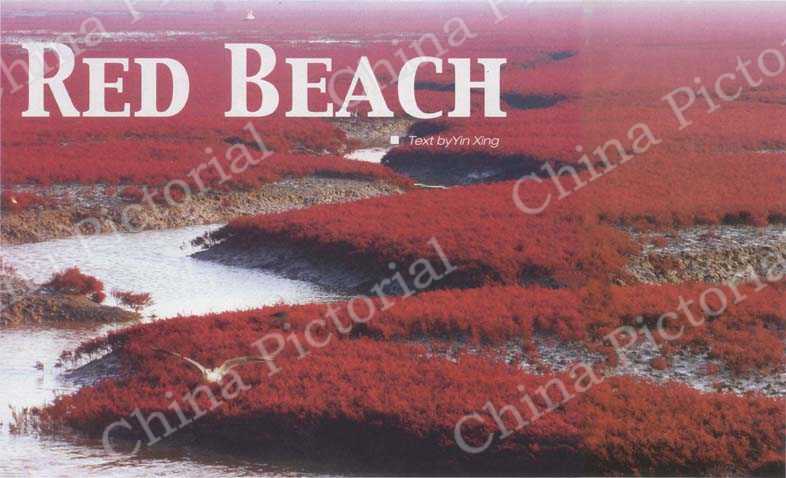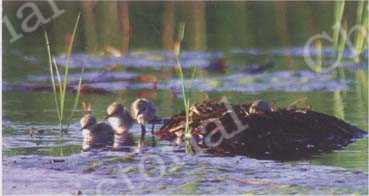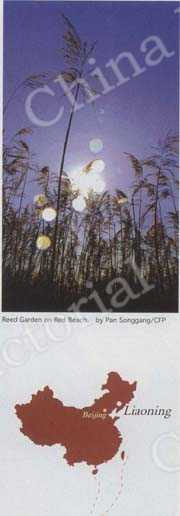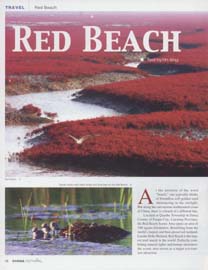
Red Beach. IC

Squab snipes with black wings and long legs on the Red Beach. IC
At the mention of the word "beach," one typically thinks of boundless soft golden sand shimmering in the sunlight. But along the curvaceous northeastern coast of China, there is a beach of a different hue. Located at Quanhe Township in Dawa County of Panjin City, Liaoning Province, the Red Beach Scenic Area spans an area of 100 square kilometers. Benefiting from the world's largest and best-preserved wetland, Liaohe Delta Wetland, Red Beach is the largest reed marsh in the world. Perfectly combining natural sights and human structures, the scenic area serves as a major eco-tour-ism attraction.
A Sea of Reed
In Reed Garden, one of the highlights of the Red Beach Scenic Area, visitors can see boundless weltering reeds everywhere; a sort of sea of reeds. The scenic area is situated at. Liaohe Delta, where Daliao, Raoyang and Panjin Rivers, and some 20 other rivers empty into the sea. Thus the area enjoys exceptional advantage for the growth of reeds, as well as serving as home for myriad and vast flocks of birds.
Inhabiting this place are 253 different breeds of birds. Among these, the red-crowned crane and Saunders's Gull are most abundant attract the most birdwatchers. In the area are a total of more than 800 red-crowned cranes, of only 2,500 in the world. About 5,000 Saunders's Gulls fly free here, of 7,000 in the world. In March, when the weather gradually warms, loud and sonorous birdcalls resound over the blue sea and across the azure sky. Hundreds of thousands of birds flap their wings, fly, land and in general form a grand and magnificent spectacle.
A Coast of Red
Beautiful and unique, the wandering seashore here is not of golden sand, nor a forest of reefs, but a stretch of tidal flat, red, like a red carpet leading to the sea.
This carpet is twined with seepweed, a sort of red herb growing alongside the seacoast. Tenacious of life, it resists salt and alkali, flood and saturation. Said to be the only plant growing on saline-alkaline soil, it breaks from the soil in April. It sprouts light red and gradually darkens. Then in October when the weather becomes cooler, it turns from red to purple, thus forming the spectacle of red beach.
Seepweed is actually not rare in the world, while the red beach is the only one. Bedload plunged by Liaohe River depositing here and soaked by tide forms the environment suitable for growing of seepweed. The gorgeous herbs grow within the area of 6,000 hectares and dye the entire extension into red.
A Crab Caught
On Red Beach there are an amazing number of crabs. Small crabs can be seen everywhere on the beach. But "fishing" for crabs on Red Beach is actually "entwining" rather than fishing. A bamboo pole and a thread, at the end of which is tied a turnbuckle compose all instruments of fishing for crabs.
The technique is not complicated. Firstly one puts the turnbuckle onto the tidal flat, and then arouses a crab with the thread. When the crab is stirred up, one waits for the chance to entwine the thread on its claws. When the angry crab tightly grasps the thread, one fleetly lifts the thread, and pulls in the crab.
Red Beach is the fruit of harmonious coexistence between humans and nature. In the past, the locals cut seepweed only when the sea iced up in freezing winter, using it for firewood. In recent years, with people's increasing consciousness of protecting wetland, the seepweed is well protected as the natural vegetation of wetland. Meanwhile, it is exploited and made use of as a kind of tourism resource. A view observatory and other tourist facilities are built on the beach. With its fame growing fast, each fall the area welcomes many tourists.



 Copy Reference
Copy Reference 